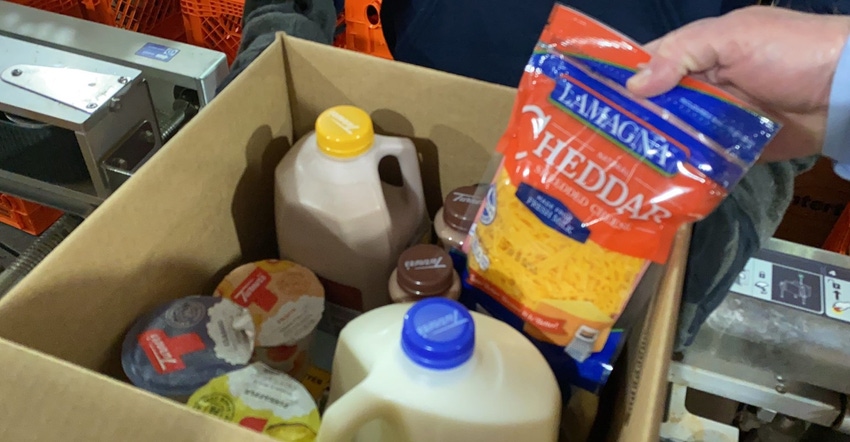USDA evaluation of Farmers to Families Food Box Program encouraged after third round of program.

The COVID-19 pandemic led to food supply disruptions. In response, the U.S. Department of Agriculture began buying about $3 billion in fruits, vegetables, dairy products and meat, packaging the food in family-sized boxes and transporting the boxes to food banks and other organizations within weeks. USDA delivered more than 74 million boxes from May 15 to Aug 27.
While USDA said it has built various oversight and monitoring features into the program, it has not evaluated programmatic aspects for the first two rounds of the program. According to USDA officials, changes to the program for the third round were a result of feedback from industry associations, recipient organizations, Congress and others. USDA said it did not plan for evaluations because it developed the Farmers to Families Food Box Program as a short-term solution to the COVID-19 outbreak.
However, a new report from the Government Accountability Office (GAO) says there are opportunities for USDA to identify successes and challenges from implementation of the program and to use lessons learned to inform future similar efforts. This would be consistent with Office of Management & Budget (OMB) guidance on the use of evaluations and other forms of evidence and federal standards for internal control to strengthen the design and operation of programs.
According to USDA, the agency obligated $2.6 billion during the first and second rounds of the program, entering into 190 contracts during the first round and adding 16 contracts during the second round. On July 24, 2020, USDA announced a third round of the program for purchases that would spend the balance of the $3 billion allocated for the program (or about $450 million). Finally, on Aug. 25, the Administration and USDA announced that USDA intends to add up to $1 billion to the third round of the program.
USDA said it developed the Farmers to Families Food Box Program in July 2020 as a short-term solution to hardships faced by American farmers due to the COVID-19 pandemic, the report noted. According to USDA officials, changes to the program for the third round were a result of emails, phone calls and letters from industry associations, recipient organizations, Congress and others providing feedback on the program, the report added.
USDA has come under fire from some Democrats in Congress for not meeting some of its initial contracts and for food not getting to those who need it most. Following a hearing by the House Agriculture Committee on July 21, Rep. Marcia Fudge (D., Ohio), who chairs the subcommittee on nutrition, oversight and department operations, criticized USDA for rushing the program out the door with little quality control regarding who gets these contracts and who is qualified to actually meet the need.
Fudge also expressed concern about the "last mile" issue of actually getting food into the hands of those who need it. Those who testified at the hearing said food pantries and charities are having to foot the bill to make sure people get the food the program promised to provide.
The first two rounds of the program, according to USDA, focused on purchasing surplus food from farmers and other agricultural entities and routing the food to any community rather than targeting specific communities. USDA made other changes related to the initial solicitation for this pool of contractors.
The GAO report stated, for example, that USDA will require contractors to cover all costs, including the “last mile,” which includes delivery to the recipient of the food box. According to USDA, including costs for the last mile ensures that food banks do not incur costs to provide food boxes. USDA had not issued region-specific solicitations and did not have a timeline for doing so as of July 28, 2020.
“Going forward, an evaluation, for example, could focus on better understanding program participation, stakeholder perspectives and lessons learned for future programs,” the report noted. “By conducting an evaluation of the Farmers to Families Food Box Program after the third round of the program, USDA would have better assurance it has identified successes and challenges from its implementation of the program that could be used to inform future similar efforts or if the program is extended.”
USDA stated that rather than evaluating the programmatic aspects for the first two rounds of the program, the Agricultural Marketing Service initiated an internal review of the program at the beginning of August 2020. This internal review, according to USDA, includes a risk-based methodology to verify that procurements were properly accounted for and that payments made to vendors were based on appropriate documentation provided by nonprofit organizations.
USDA said in its view, such a review would be more cost-effective, have more of an impact and provide assurance that funds were adequately expended. Second, according to USDA, the Farmers to Families Food Box Program is expected to be completed by the end of October 2020. Therefore, USDA stated, the costs of conducting an evaluation after the program is over would seem to outweigh the benefits. Finally, USDA said any reviews could be redundant because the program is being reviewed internally by the Office of the Chief Financial Officer and externally by GAO and the USDA Office of Inspector General.
About the Author(s)
You May Also Like



.png?width=300&auto=webp&quality=80&disable=upscale)

